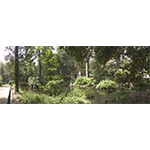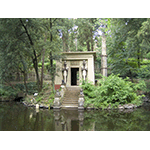Stibbert Garden
In keeping with the fashion of landscaped gardens of the time, around 1870 Frederick Stibbert transformed the pre-existing garden into a fascinating romantic English park, enlivened by waterworks and elegant decorative elements. The Hellenistic temple with a cupola lined with flaked majolica tiles and many other decorative elements, recall the late romantic flavour for antiquities, while the neo-Egyptian temple, probably designed by Giuseppe Poggi and realised between 1862 and 1864, which faces a manmade lake, reveals the passion for the ancient age of the pharaohs, it too, typical of nineteenth-century culture. Here and there along the many alleys, are sculptures and classical busts in terracotta. An elegant lemon-house in the neoclassical style was built to shelter the citrus trees and more delicate plants.
With a surface area of almost four hectares, the park is also noteworthy from the botanical viewpoint: it has 56 species distributed among 612 specimens. Each species is marked by cards that make it possible to visit the garden following fascinating learning trails. For several years now, the Council of Quarter 5 of the Commune of Florence has supported the maintenance and care of the park and its furnishings, and is implementing a programme to recover the original layout, based on studies conducted by the museum.
****************************
Texts by Graziano Magrini
English translation by Victor Beard
Last update 08/feb/2008





